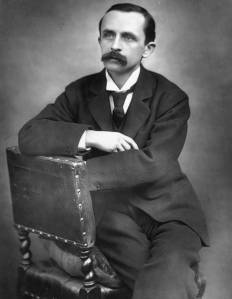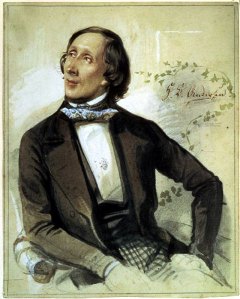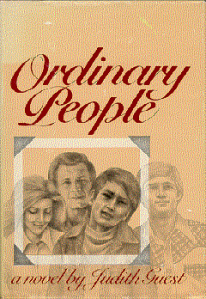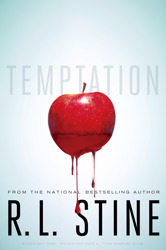 “May God blast anyone who writes a biography of me,” declared J.M. Barrie, in a curse sprawled across the pages of one his last notebooks. Hopefully, no curses will ensue as I write about the man who seemed to harbor child-like tendencies and be fascinated with the concept of never growing up.
“May God blast anyone who writes a biography of me,” declared J.M. Barrie, in a curse sprawled across the pages of one his last notebooks. Hopefully, no curses will ensue as I write about the man who seemed to harbor child-like tendencies and be fascinated with the concept of never growing up.
J.M. Barrie was born in Kirriemuir, Scotland on May 9, 1860, and is most known for writing the famous story of “Peter Pan” or “The Boy Who Would Never Grow Up.” Barrie was born to a conservative Calvinist family. His father, David Barrie, was a modestly successful weaver, and his mother Margaret, had assumed her deceased mother’s household responsibilities at the age of eight. When Barrie was six years old his older brother David died two days before his 14th birthday in an ice-skating accident. This left his mother completely devastated because David was supposedly her favorite child. Interestingly, Barrie often wore his older brother’s clothing and mimicked his mannerisms in order to appease his mother. Barrie’s mother found comfort in the fact her deceased son would remain a boy forever, never to grow up and leave her. This childhood trauma that Barrie experienced could be related to his character Peter Pan, who has similar aspirations of not wanting to grow up.
Throughout his childhood and adolescence, Barrie attended various academies and then later enrolled at University of Edinburgh to further his education. Barrie was always quite shy and introverted but most of this insecurity was brought on by the fact that he was only about five feet tall and often felt like a child who was attending university. Barrie had wanted to be an author but his family was hesitant and instead encouraged him into ministry. Barrie later found a compromise and from the advice of one of his brothers he settled on studying literature. After graduating from university in 1882, Barrie attained a job in journalism working for the Nottingham Journal. Although critics disparaged his early work, calling it sentimental and nostalgic and not acknowledging the modernism sweeping over Scotland, he was popular enough to be considered a successful writer.
Barrie published his first novel “Better Dead” in 1887 and had other various strings of popular novels set in Scotland. After having some success with fiction, Barrie began writing plays in the 1890s His third play, “Walker, London” helped him to be introduced to his future ex-wife Mary Ansell, who was an actress at the time. Although Barrie was unsure about his suitability for marriage, he proposed to Ansell and they married in 1894. However, speculations have been made that the marriage was not consummated and rumors flew about Barrie’s possible asexuality and Ansell’s infidelity. Due to such conflicts, the couple divorced after 15 years of marriage.
During the difficult times throughout his marital home-life, Barrie would often go out for long walks in London’s Kensington Gardens. This is where he met the five Llewelyn Davies brothers and their mother in the late 1890’s, who would later become the inspiration for his most famous work. After getting to know them more personally, he often entertained the boys regularly with his stories and became a regular visitor at the Davies household and a companion to the boys and their mother, despite the fact that both of them were married to other people.
The character of Peter Pan was invented to entertain two of the Davies boys, George and Jack. In order to amuse them, Barrie would often say that their little brother Peter could fly. He claimed that babies were birds before they were born and parents put bars on nursery windows to keep the little ones from flying away. This innocent story grew into a tale of a baby boy named Peter Pan who did fly away. The character first appeared in the 1902 book “The Little White Bird” and two years later his play “Peter Pan” premiered on the London stage and became great a success. Audiences were intrigued by the fantastical tale of the flying boy who never grew up and his adventures in Neverland with the Darling children. Barrie also wrote a book based on the play called “Peter and Wendy,” which was published in 1911. The book also earned rave reviews from the critics.
The father of the Davies boys died in 1907 and ever since Barrie was referred to as “Uncle Jim” and became more involved in the family. Following their mother Sylvia’s death in 1910, Barrie became a legal guardian of the boys as wished by Sylvia in her will. Barrie claimed that they had been engaged to be married before her death but nothing of the sort was indicated in Sylvia’s will. Barrie’s relationship with the Davies boys remained strong and endured many years. There has since been speculation that Barrie was a pedophile and had developed unacceptable feelings for the boys. However, the Davies boys themselves have said that Barrie was like a father-figure and nothing of the sort ever crossed their minds. Barrie suffered a great loss when one of the boys died in battle in WWI and another, Peter, who committed suicide by jumping in front of a train.
After the hugely successful “Peter Pan”, Barrie continued writing plays but now aimed his content to a much older audience. Several of his later works had a darker element to them. Many of them dealt with unhappy marriages such as “Half an Hour” that was published in 1913, was about a woman who plans on leaving her husband for another man. His last major play, “Mary Rose,” was produced in 1920 and revolved around a son visited by his mother’s ghost.
J.M. Barrie died on June 19, 1937, of pneumonia in London. As a part of his will, he gave the copyright to “Peter Pan” to a children’s hospital in London. Barrie’s “Peter Pan” has left a profound mark on the literary world and to this day his play has been garnering movie and book renditions. There have been many speculations and rumors about Barrie’s true persona but nonetheless the man had a knack for creating a magical world where children can truly explore their freedoms without having to endure the hardships that come along with adulthood. The only rumor that I believe to be true is that J.M. Barrie himself was truly Peter Pan.



 of these morbiddetails are from the famous Stephen King horror novel and movie, respectively, “The Shining.” “The Shining” was published in 1977 and three years later it was adapted to the silver screen starring Jack Nicholson. This was King’s third published novel and its success launched him as a preeminent author in the horror genre.
of these morbiddetails are from the famous Stephen King horror novel and movie, respectively, “The Shining.” “The Shining” was published in 1977 and three years later it was adapted to the silver screen starring Jack Nicholson. This was King’s third published novel and its success launched him as a preeminent author in the horror genre.

 style and wrote many dark pieces including “The Raven” and “The Tell-Tale Heart,” but that does not mean he was a morbid individual. Much of what people know about Poe is wrong and that is the unfortunate result of a biography written by one of his enemies in an attempt to defame the author’s name.
style and wrote many dark pieces including “The Raven” and “The Tell-Tale Heart,” but that does not mean he was a morbid individual. Much of what people know about Poe is wrong and that is the unfortunate result of a biography written by one of his enemies in an attempt to defame the author’s name.